Flag 'Corona'- OPOD
Flag 'Corona': Exploring the Optical Phenomenon Behind Vibrant Colors
Have you ever noticed a flag adorned with circles of pastel colors resembling a corona? This captivating sight, captured by Glenn E Johnson, raises questions about the fascinating interplay of light and fabrics. In this article, we will delve into the optical phenomenon behind the flag 'corona' and explore the various factors that contribute to its mesmerizing appearance.
Unraveling the Mystery of Flag 'Corona'
At first glance, one might assume that the flag's vibrant colors are a result of diffraction from the threads of the fabric as it flutters in the wind. However, calculations quickly debunk this hypothesis. Measurements taken from the uncropped image, combined with camera EXIF data, reveal that the diameter of the first red ring is approximately 8.9°. Astonishingly, an IRIS Mie scattering calculation indicates that this corresponds to objects a mere 14 microns (0.014mm) in size—significantly smaller than the main threads of the cloth.
The Quest for a Fabric Diffraction Grating
Could it be that the flag itself acts as a diffraction grating, producing the captivating corona-like colors? While this notion seems plausible, there are a few challenges to consider. A diffraction pattern created by a fabric would typically manifest as a rectangular arrangement of colored patches, rather than rings. Furthermore, the required thread spacing to produce such a pattern would necessitate a fabric with approximately 150 threads per millimeter—finer than anything currently available.
Fine Filament Diffraction: Unveiling the True Cause
The secret behind the flag 'corona' lies in the fine filaments that make up the yarn used in fabrics. These filaments, which protrude from the surface like delicate hairs, scatter light passing through the gaps in the fabric. Their alignment is more or less random, resulting in the formation of a corona-like pattern. In the case of the flag, filaments with a diameter of around 14 microns are responsible for this captivating optical phenomenon. To put it into perspective, human hair typically ranges from 20 to 200 microns in diameter.
Observing the Microscopic World of Coronas
Next time you encounter a corona in a flag or curtain, take a closer look under a microscope. You will be amazed by the intricate beauty revealed by the fine filaments scattered throughout the fabric. It is through this microscopic lens that we can truly appreciate the intricate interplay of light and materials, giving rise to mesmerizing optical phenomena.
A Kaleidoscope of Colors: Exploring Further Applications
The flag 'corona' phenomenon not only captivates our visual senses but also has implications beyond its aesthetic appeal. Understanding the underlying principles behind such optical phenomena enables scientists and engineers to develop innovative materials and technologies. By harnessing the scattering properties of fine filaments, researchers can explore applications ranging from advanced light diffusers to enhanced optical displays.
Acknowledging the Source of Knowledge
In the quest to unravel the mysteries of atmospheric optics, we owe gratitude to experts like David Lynch, author of "Color & Light in Nature," whose valuable insights have contributed to our understanding of these captivating phenomena. Their expertise allows us to appreciate and comprehend the intricate workings of our natural world.
As we delve deeper into the realm of atmospheric optics, we continue to uncover remarkable phenomena that both astound and inspire us. The flag 'corona' serves as a reminder of the hidden wonders that surround us and the complex interplay of light and materials that shape our visual experiences. So, next time you encounter a corona-like pattern in a flag or curtain, take a moment to marvel at the microscopic world that lies beneath its vibrant surface.
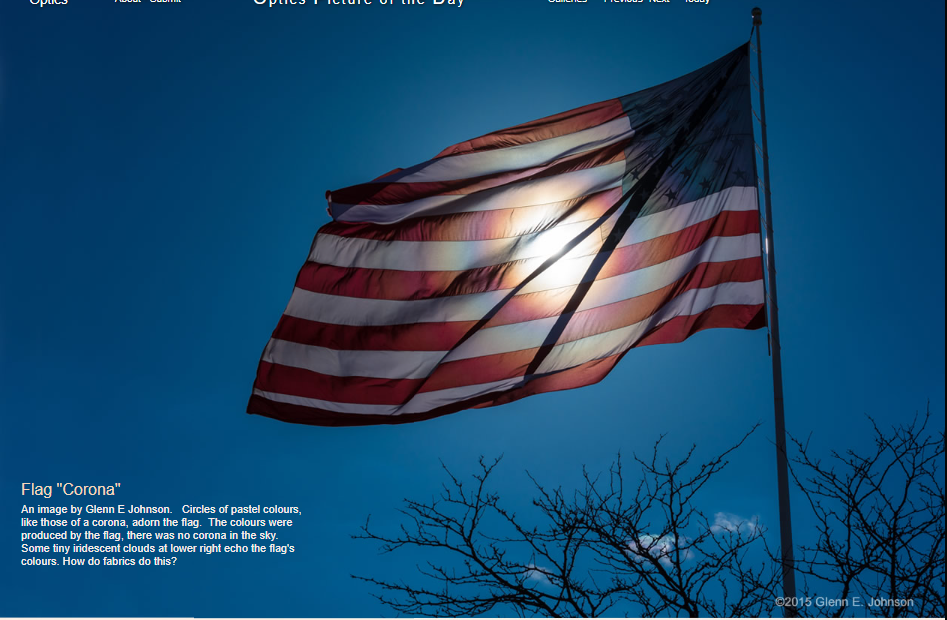
Flag "Corona"
An image by Glenn E Johnson. Circles of pastel colours, like those of a corona, adorn the flag. The colours were produced by the flag, there was no corona in the sky. Some tiny iridescent clouds at lower right echo the flag's colours. How do fabrics do this?
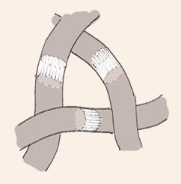
Yarn diffraction
The flag colours are definitely corona like. Perhaps there is diffraction from the threads of the fabric that may be pseudo randomly oriented as the flag flaps? Imagine diffraction from the white elements at left.
Calculations quickly destroy this hypothesis. Measurements on the uncropped image together with the camera EXIF data give the diameter of the first red ring as 8.9°. An IRIS Mie scattering calculation says this comes from objects only 14 micron (0.014mm) across, objects far smaller than the main threads of the cloth.
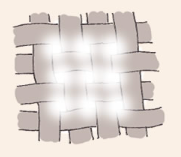
A fabric diffraction grating?
Light shines through the array of holes that might act as a diffraction grating. There is an immediate problem. The diffraction pattern would be a rectangular arrangement of coloured patches rather than rings. We can also compute the thread spacing that would produce the pattern. Unfortunately a fabric of some 150 threads per mm is needed – finer than anything we have. Arachne might have woven it, but we know her fate.
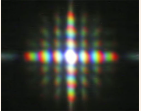
Diffraction pattern from a wire mesh window screen. Alan Clarke pictured Venus shining through the screen.
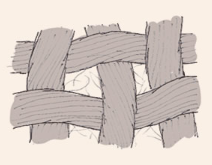
Fine filament diffraction
Yarn is usually composed of twisted strands of much finer material. Some of these finer filaments can stick out from the surface rather like hairs. It is likely that light shining through the gaps in the fabric is scattered by these filaments. Their alignment is more or less random and a corona would indeed be formed. We need in this instance filaments 14 micron in diameter which is plausible. By comparison, human hair is 20 – 200 μm diameter. Next time you see a corona in a flag or curtain, examine it under a microscope!
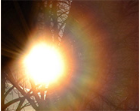
A corona from the fine filaments of a knitted glove. An image by Monika Landy-Gyebnar.
My thanks to David Lynch, author of Color & Light in Nature, for helpful input.
Note: this article has been automatically converted from the old site and may not appear as intended. You can find the original article here.
Reference Atmospheric Optics
If you use any of the definitions, information, or data presented on Atmospheric Optics, please copy the link or reference below to properly credit us as the reference source. Thank you!
-
<a href="https://atoptics.co.uk/blog/flag-corona-opod/">Flag 'Corona'- OPOD</a>
-
"Flag 'Corona'- OPOD". Atmospheric Optics. Accessed on April 18, 2024. https://atoptics.co.uk/blog/flag-corona-opod/.
-
"Flag 'Corona'- OPOD". Atmospheric Optics, https://atoptics.co.uk/blog/flag-corona-opod/. Accessed 18 April, 2024
-
Flag 'Corona'- OPOD. Atmospheric Optics. Retrieved from https://atoptics.co.uk/blog/flag-corona-opod/.